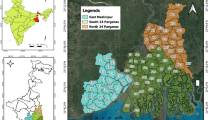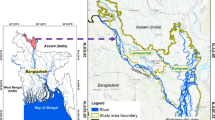Abstract
In Asia, rice is a staple cereal crop and the continent accounts for about 90 % of the global rice production and consumption. Statistics on the areas planted with rice or production of paddy rice are fundamental to agriculture-related decisions or policy-making. Asia-Rice Crop Estimation & Monitoring (Asia-RiCE) aims to develop rice-related information, such as paddy field maps, rice growing conditions, yield, and production, using remote sensing tools and disseminate the same at the local and global scales. In this paper, we propose a methodology for the identification of rice-planted areas by using multi-temporal SAR images; a software named INternational Asian Harvest mOnitoring system for Rice (INAHOR) was developed to manipulate the proposed algorithm. The INAHOR uses the imagery observed both at the time of planting of rice and grown-up stages. In this study, two thresholds needed for the INAHOR were optimized based on the detailed land cover data collected through a field survey. Rice-planted areas across the study area in Japan were identified by the INAHOR using the RADARSAT-2 Wide Fine beam mode data. The classification results of RADARSAT-2 VV and VH polarizations were compared. The data with VH polarization showed a higher total accuracy of 83 % with −20.5 dB and 3.0 dB for the minimum and range thresholds, respectively. The INAHOR is currently being used with the RADARSAT-2, ALOS, and ALOS-2 SAR data in the Southeast Asian countries to assess the robustness of the thresholds and classification accuracies under the framework of Asia-RiCE.









Similar content being viewed by others
References
Agriculture Market Information System (AMIS) (2013) Market monitor No. 11 September 2013. http://www.amis-outlook.org/fileadmin/user_upload/amis/docs/Market_monitor/AMIS_Market_Monitor_Issue_11.pdf. Accessed 10 November 2014
Asia-RiCE (2012) Asia-Rice work plan. http://www.asia-rice.org/workplan.php. Accessed 10 November 2014
G20 Agricultural Ministers (2011) Action plan on food price volatility and agriculture. Meeting of G20 Agricultural Ministers, Paris, France, 22–23 June 2011
G20 Summit (2011) Cannes Summit final declaration. https://g20.org/wp-content/uploads/2014/12/Declaration_eng_Cannes.pdf. Accessed 10 Nov 2014
Group on Earth Observations (GEO) (2011) GEO-GLAM (Global Agriculture Monitoring Initiative). http://www.earthobservations.org/geoglam.php. Accessed 10 November 2014
Inoue Y, Sakaiya E (2013) Relationships between X-band backscattering coefficients from high-resolution satellite SAR and biophysical variables in paddy rice. Remote Sens Lett 4(3):288–295
Inoue Y, Kurosu T, Maeno H, Uratsuka S, Kozu T, Dabrowska-Zielinska K, Qi J (2002) Season-long daily measurements of multifrequency (Ka, Ku, X, C, and L) and full-polarization backscatter signatures over paddy rice field and their relationship with biological variables. Remote Sens Environ 81:194–204
Kurosu T, Fujita M, Chiba K (1995) Monitoring of rice crop growth from space using the ERS-1 C-band SAR. IEEE Trans Geosci Remote Sens 33(4):1092–1096
Ministry of Agriculture, Forestry and Fisheries Japan (2014) Crop statistics. http://www.maff.go.jp/j/tokei/kouhyou/sakumotu/menseki/pdf/menseki_sakumotu_13.pdf. Accessed 10 November 2014
Okamoto K, Kawashima H (1999) Estimation of rice-planted are in the tropical zone using a combination of optical and microwave satellite sensor data. Int J Remote Sens 20(5):1045–1048
Peña-Barragán JM, Ngugi MK, Plant RE, Six J (2011) Object-based crop identification using multiple vegetation index, textural features and crop phenology. Remote Sens Environ 115:1301–1316
Rosenqvist A, Shimada M, Suzuki S, Ohgushi F, Tadono T, Watanabe M, Tsuzuku K, Watanabe T, Kamijo S, Aoki E (2014) Operational performance of the ALOS global systematic acquisition strategy and observation plans for ALOS-2 PALSAR-2. Remote Sens Environ 155:3–12
Sakamoto T, Nguyen NV, Ohono H, Ishitsuka N, Yokozawa M (2006) Spatio–temporal distribution of rice phenology and cropping systems in the Mekong Delta with special reference to the seasonal water flow of the Mekong and Bassac rivers. Remote Sens Environ 100:1–16
Toan TL, Laur H, Mougin E, Lopes A (1989) Multitemporal and dual-polarization observations of agricultural vegetation covers by X-Band SAR Images. IEEE Trans Geosci Remote Sens 27(6):709–718
Toan TL, Ribbes F, Wang L, Floury N, Ding K, Kong JA, Fujita M, Takashi K (1997) Rice crop mapping and monitoring using ERS-1 data based on experiment and modeling results. IEEE Trans Geosci Remote Sens 35(1):41–56
Whitcraft AK, Becker-Reshef I, Justice CO (2015) A Framework for Defining Spatially Explicit Earth Observation Requirements for a Global Agricultural Monitoring Initiative (GEOGLAM). Remote Sens 7:1461–1481
Zhang Y, Wang C, Wu J, Qi J, Salas WA (2009) Mapping paddy rice with multitemporal ALOS/PALSAR imagery in southeast China. Int J Remote Sens 30(23):6301–6315
Acknowledgments
The authors would like to express their gratitude to Mr. Takuma Anahara at the Earth Observation Research Center (EORC), Japan Aerospace Exploration Agency (JAXA) for conducting the field survey, and the Canadian Space Agency (CSA) for providing RADARSAT-2 data through the Science and Operational Applications Research (SOAR)—Joint Experiment of Crop Assessment and Monitoring (JECAM) project.
Author information
Authors and Affiliations
Corresponding author
Rights and permissions
About this article
Cite this article
Oyoshi, K., Tomiyama, N., Okumura, T. et al. Mapping rice-planted areas using time-series synthetic aperture radar data for the Asia-RiCE activity. Paddy Water Environ 14, 463–472 (2016). https://doi.org/10.1007/s10333-015-0515-x
Received:
Revised:
Accepted:
Published:
Issue Date:
DOI: https://doi.org/10.1007/s10333-015-0515-x




